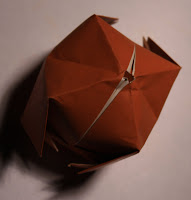
Black lava beads are cool, lightweight, great texture and classic basic black. One day I was looking at these beads and thought what if I ‘inlaid’ them with polymer clay to add color and dimension. So I gave it a try. After firing the beads I wondered how strong the polymer clay would hold to the lava beads. I took the finished beads and dropped them repeatedly onto a cement floor from a height of 8 feet. None of the polymer clay came out. The process is simple and changes the look of the lava beads. The process I outlined here is to create a turquoise look on the beads; of course any color or color combinations of your choosing can be used.
Lava Beads
Polymer clay - turquoise, blue, green
Pallet knife or something similar
Oven

I begin by mixing three colors of polymer clay, turquoise, lapis blue and forest green. I do mix until completely blended, I mix until it has a marble look.

Select beads to be ‘inlaid’. Work a small amount of the color polymer clay you want to begin with between you fingers to soften. Push small amounts of the polymer clay into the holes in the lava beads. Using your pallet knife or similar tool to press, smooth and scrape the clay off the surface of the bead. Repeat this process around the beads until the desired amount of the bead is ‘inlaid’. I do not try to fill every whole in the bead, however this is completely up to you.




 Slide ‘inlaid’ bead/s onto floral wire. When all beads are prepared and on the floral wire bend the ends of the floral wire creating a rack to keep the beads from touching the foil or baking sheet beneath them.
Slide ‘inlaid’ bead/s onto floral wire. When all beads are prepared and on the floral wire bend the ends of the floral wire creating a rack to keep the beads from touching the foil or baking sheet beneath them.

Fire the beads according to the manufactures directions for the polymer clay you are using. Allow the beads to cool. If you want a gloss finish on your beads spray them with a gloss sealant before taking them off the floral wire. Once cooled and dry your beads are ready to use.




























 ves were then strung on long strands with beads ending with small globes. These doves measured about 4" in length. These were installed in Holy Click gallery, Phoenix, AZ in the spring of 2006. Subsequently I created a mobile with the origami doves being about 1.5" in length. Creating a smaller piece not needing nearly as much space to display(photo to right). After that the idea of folding origami doves from paper printed with all the flags on one sheet came about. I created this paper next and began producing these Peace Dove Ornaments. I have offered this item in my Etsy shop, QuietMind, for a year now and have had numerous orders. Several buyers requested the ornament be sent to an alternate party as a gift. Including a note or card on the buyers behalf. Then came the next turn in evolution of this product; now the buyer can select one of three card designs, have the card inscribed as they wish and the wrapped ornament with card sent as a gift any where in the world, t
ves were then strung on long strands with beads ending with small globes. These doves measured about 4" in length. These were installed in Holy Click gallery, Phoenix, AZ in the spring of 2006. Subsequently I created a mobile with the origami doves being about 1.5" in length. Creating a smaller piece not needing nearly as much space to display(photo to right). After that the idea of folding origami doves from paper printed with all the flags on one sheet came about. I created this paper next and began producing these Peace Dove Ornaments. I have offered this item in my Etsy shop, QuietMind, for a year now and have had numerous orders. Several buyers requested the ornament be sent to an alternate party as a gift. Including a note or card on the buyers behalf. Then came the next turn in evolution of this product; now the buyer can select one of three card designs, have the card inscribed as they wish and the wrapped ornament with card sent as a gift any where in the world, t




